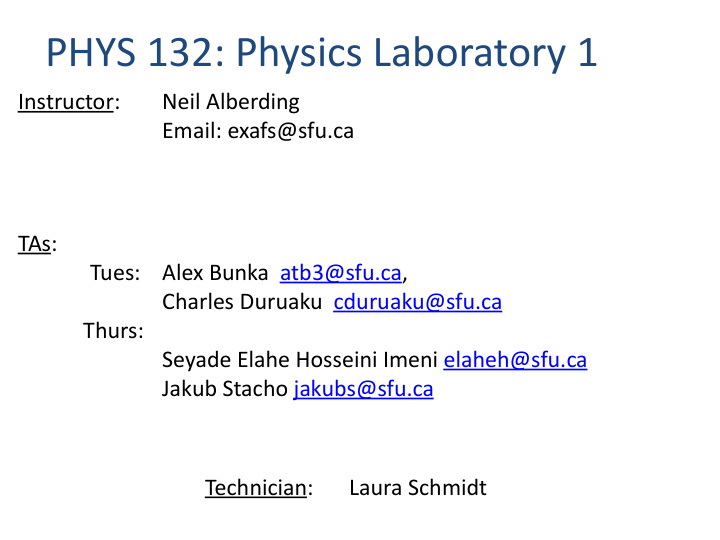



PHYS ¡132: ¡Physics ¡Laboratory ¡1 Instructor: ¡ ¡ Neil ¡Alberding ¡ ¡ ¡ Email: ¡exafs@sfu.ca ¡ ¡ TAs: ¡ ¡ Tues: ¡ Alex ¡Bunka ¡ ¡atb3@sfu.ca, ¡ ¡ ¡ Charles ¡Duruaku ¡ ¡cduruaku@sfu.ca ¡ ¡ ¡ ¡ ¡ ¡ ¡ ¡ ¡ ¡ ¡ ¡ ¡Thurs: ¡ ¡ ¡ ¡ Seyade ¡Elahe ¡Hosseini ¡Imeni ¡elaheh@sfu.ca ¡ ¡ ¡ Jakub ¡Stacho ¡jakubs@sfu.ca ¡ ¡ Technician: ¡ ¡ Laura ¡Schmidt
Text ¡resources Other: ¡Taylor ¡ ¡ Recommended ¡(used ¡in ¡later ¡ Older ¡but ¡still ¡good ¡text. ¡You ¡will ¡ physics ¡labs) ¡: ¡ see ¡references ¡to ¡this ¡text ¡in ¡ Hughes ¡and ¡Hase notes. ¡ ¡
PHYS ¡132: ¡Physics ¡Laboratory ¡1 • First ¡in ¡sequence ¡of ¡two ¡lab ¡courses: ¡PHYS ¡132(1) ¡& ¡PHYS ¡133(1).
PHYS ¡132: ¡Physics ¡Laboratory ¡1 • First ¡in ¡sequence ¡of ¡two ¡lab ¡courses: ¡PHYS ¡132(1) ¡& ¡PHYS ¡133(1). • 8×3-‑hour ¡labs ¡plus ¡1 ¡‘makeup ¡period’ ¡at ¡the ¡end.
PHYS ¡132: ¡Physics ¡Laboratory ¡1 • First ¡in ¡sequence ¡of ¡two ¡lab ¡courses: ¡PHYS ¡132(1) ¡& ¡PHYS ¡133(1). • 8×3-‑hour ¡labs ¡plus ¡1 ¡‘makeup ¡period’ ¡at ¡the ¡end. • Fall ¡2020 ¡Schedule:
PHYS ¡132: ¡Physics ¡Laboratory ¡1 • First ¡in ¡sequence ¡of ¡two ¡lab ¡courses: ¡PHYS ¡132(1) ¡& ¡PHYS ¡133(1). • 8×3-‑hour ¡labs ¡plus ¡1 ¡‘makeup ¡period’ ¡at ¡the ¡end.
PHYS ¡132: ¡Physics ¡Laboratory ¡1 • First ¡in ¡sequence ¡of ¡two ¡lab ¡courses: ¡PHYS ¡132(1) ¡& ¡PHYS ¡133(1). • 8×3-‑hour ¡labs ¡plus ¡1 ¡‘makeup ¡period’ ¡at ¡the ¡end. • Work ¡individually
PHYS ¡132: ¡Physics ¡Laboratory ¡1 • First ¡in ¡sequence ¡of ¡two ¡lab ¡courses: ¡PHYS ¡132(1) ¡& ¡PHYS ¡133(1). • 8×3-‑hour ¡labs ¡plus ¡1 ¡‘makeup ¡period’ ¡at ¡the ¡end. • Work ¡individually • Lab ¡notes ¡and ¡worksheets ¡to ¡be ¡done ¡by ¡each ¡student ¡and ¡ ¡ uploaded ¡to ¡Canvas.
PHYS ¡132: ¡Physics ¡Laboratory ¡1 • First ¡in ¡sequence ¡of ¡two ¡lab ¡courses: ¡PHYS ¡132(1) ¡& ¡PHYS ¡133(1). • 8×3-‑hour ¡labs ¡plus ¡1 ¡‘makeup ¡period’ ¡at ¡the ¡end. • Work ¡individually • Lab ¡notes ¡and ¡worksheets ¡to ¡be ¡done ¡by ¡each ¡student ¡and ¡ ¡ uploaded ¡to ¡Canvas. • All ¡course ¡information ¡and ¡labscripts ¡posted ¡on ¡(or ¡accessed ¡via) ¡ Canvas.
PHYS ¡132: ¡Physics ¡Laboratory ¡1 • First ¡in ¡sequence ¡of ¡two ¡lab ¡courses: ¡PHYS ¡132(1) ¡& ¡PHYS ¡133(1). • 8×3-‑hour ¡labs ¡plus ¡1 ¡‘makeup ¡period’ ¡at ¡the ¡end. • Work ¡individually • Lab ¡notes ¡and ¡worksheets ¡to ¡be ¡done ¡by ¡each ¡student ¡and ¡ ¡ uploaded ¡to ¡Canvas. • All ¡course ¡information ¡and ¡labscripts ¡posted ¡on ¡(or ¡accessed ¡via) ¡ Canvas. • Weekly ¡prelab ¡quiz ¡on ¡Canvas; ¡deadline ¡prior ¡to ¡lab ¡session.
How ¡the ¡lab ¡is ¡run • Each ¡student ¡takes ¡all ¡roles: ¡Experimenter, ¡Analyst, ¡Recorder..
How ¡the ¡lab ¡is ¡run • Each ¡student ¡takes ¡all ¡roles: ¡Experimenter, ¡Analyst, ¡Recorder.. • Warm-‑up ¡Activity, ¡Lab ¡Experiment, ¡Wrap-‑up.
How ¡the ¡lab ¡is ¡run • Each ¡student ¡takes ¡all ¡roles: ¡Experimenter, ¡Analyst, ¡Recorder.. • Warm-‑up ¡Activity, ¡Lab ¡Experiment, ¡Wrap-‑up. • Lab ¡Experiment: ¡Explore/Estimate, ¡Measure ¡and ¡Analyze, ¡ Refine ¡Measurements, ¡Wrap-‑up.
Attendance ¡and ¡Grading • Must ¡complete ¡7/8 ¡labs ¡to ¡pass ¡the ¡course ¡ • Grade: ¡10% ¡pre-‑lab ¡quizzes; ¡25% ¡warm ¡up, ¡75% ¡Lab ¡notes
What ¡to ¡do ¡/ ¡expect ¡for ¡next ¡week? • Log ¡on ¡to ¡Canvas ¡and ¡follow ¡the ¡links ¡to ¡the ¡PHYS ¡132/133 ¡wiki. ¡ This ¡will ¡be ¡your ¡primary ¡reference ¡throughout ¡the ¡course. ¡ • Read ¡the ¡Script ¡for ¡Lab ¡1; ¡this ¡will ¡list ¡all ¡of ¡the ¡other ¡preparatory ¡ reading ¡that ¡needs ¡to ¡be ¡done. ¡ • Do ¡the ¡pre-‑lab ¡quiz ¡before ¡the ¡lab ¡starts. • I’ll ¡give ¡a ¡very ¡brief ¡introduction ¡and ¡then ¡students ¡ work ¡on ¡the ¡warm ¡up ¡and ¡continue ¡on ¡working ¡on ¡the ¡ experiment. ¡ • Warm-‑up ¡is ¡due ¡at ¡4:30 ¡pm ¡on ¡the ¡day ¡of ¡the ¡lab ¡ • Lab ¡notes ¡due ¡at ¡midnight ¡the ¡next ¡day
What ¡to ¡do ¡? Warm-‑up • Practice ¡for ¡some ¡aspect ¡of ¡the ¡lab ¡that ¡is ¡going ¡to ¡be ¡ important. ¡ • Don’t ¡forget ¡lessons ¡learned ¡during ¡the ¡warm-‑up ¡as ¡soon ¡as ¡ you ¡start ¡working ¡on ¡the ¡lab. ¡They ¡are ¡there ¡for ¡a ¡reason! ¡
What ¡to ¡do ¡? Estimate ¡and ¡Explore Estimate: ¡not ¡a ¡measurement; ¡just ¡context; ¡often ¡no ¡need ¡to ¡ use ¡any ¡tools ¡at ¡all! Explore: ¡what ¡matters, ¡and ¡what ¡doesn’t ¡? ¡ ¡How ¡are ¡you ¡going ¡to ¡ minimize ¡uncertainties ¡to ¡get ¡the ¡best ¡possible ¡measurement? Measurement ¡and ¡Analysis This ¡is ¡where ¡you ¡perform ¡the ¡best ¡measurement ¡you ¡can ¡ based ¡on ¡the ¡procedure ¡worked ¡out ¡above, ¡and ¡derive ¡an ¡ uncertainty ¡to ¡support ¡your ¡result. Refinement It ¡is ¡almost ¡always ¡possible ¡to ¡do ¡better; ¡how ¡can ¡you ¡improve ¡your ¡ result? ¡If ¡something ¡didn’t ¡work ¡out ¡as ¡expected, ¡do ¡something ¡ about ¡it! ¡
What ¡to ¡do ¡? Wrap-‑up A ¡ ¡brief ¡summary: ¡What ¡did ¡you ¡set ¡out ¡to ¡do? ¡What ¡did ¡you ¡ observe? ¡What ¡are ¡you ¡able ¡to ¡conclude? ¡The ¡questions ¡are ¡ there ¡to ¡lead ¡you ¡through ¡an ¡assessment ¡of ¡your ¡own ¡work! Avoid ¡writing ¡vague ¡statements ¡like ¡‘Yes, ¡it ¡worked. ¡We ¡got ¡42 ¡for ¡ an ¡answer.’ ¡No ¡one ¡else ¡will ¡understand ¡what ¡you ¡mean. ¡Provide ¡ enough ¡context ¡so ¡that ¡the ¡reader ¡doesn’t ¡have ¡to ¡go ¡back ¡and ¡ read ¡the ¡question. ¡ ¡
Activities Sequence: ¡Explore/Estimate, ¡Measure ¡and ¡Analyze, ¡Refine ¡
Recommend
More recommend